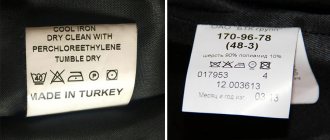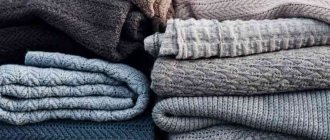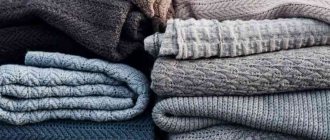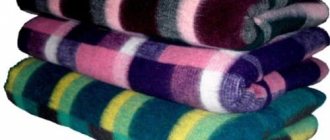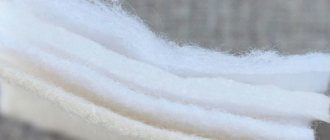Secrets of machine washing efficiency
How to choose the right parameters
Washing blankets will be effective if you study the information on the product label. The parameters for automatic washing will be different, so before washing the blanket, you need to pay attention to the type of material.
Synthetic items are easy to wash, you just need to select a program for synthetics. The main parameter is temperature. For acrylic, faux fur and polyester, it should not exceed 40 degrees. Faux fur does not like spinning in the machine: it must dry on its own.
Delicate fabrics require careful care. To avoid damage to the fibers, it is better to hand wash fur, fleece, cashmere and wool items. This is a labor-intensive process, not all housewives have the time and desire for it, so you can use delicate washing. Smooth rotation of the drum minimizes the negative effect on the material. It wiggles in a way that is similar to what happens when you wash it by hand. Delicate fabrics should not be wrung out.
Note! Information on how to wash a blanket when it is covered in stains is especially relevant for those who have small children. The product must first be soaked using a stain remover.
What you need to consider for quality washing
Crumple up small items before loading, and roll up large items.
The drum must hold at least 5 kg of laundry. Also, you cannot load an item that weighs more than the instructions for the automatic washing machine allow.
Additional Information! Recommendations on how to wash a blanket in a washing machine are based on its property of increasing weight when wet. This nuance must be taken into account when loading.
You should choose the spin speed carefully. It is better not to wring out soft fabric with fine fibers. Let it dry longer, but not deform.
No need to twist. Remove excess water using smoothing movements, then shake and hang the product on a clothesline.
It is better to avoid automatic drying for synthetic and delicate fabrics.
Blankets are cleaned with concentrated liquid or gel products, because they do an excellent job of removing dirt and are easier to wash out.
Large and voluminous
Washing a large, voluminous blanket is a difficult task for a fragile woman, so you definitely need an assistant with physical strength.
In a private home, you can wash a large item in the same way as for carpets . Necessary:
- Hang a blanket outside.
- Prepare a soap solution.
- Apply the liquid with a brush, paying attention to the most contaminated areas.
- Rinse thoroughly with clean water from a hose.
- Dry, avoiding direct sunlight.
If none of the methods is suitable, there is only one way out - professional dry cleaning.
This video will show you how to clean a large blanket:
How to wash by hand
Before you wash a large blanket at home by hand, you must follow the following sequence of steps:
- fill the bathtub with water at room temperature;
- dissolve the detergent;
- after immersing the blanket, wait 15 minutes;
- wash the item with light movements without twisting or stretching;
- rinse the product;
- Gently straighten and hang on a line to dry. The water will drain naturally.
Principles of cleaning
Before sending a blanket or blanket for washing, carefully inspect the product. It is recommended to immediately remove major contaminants:
- A sticky roller will help get rid of cat hair and the hair of other animals;
- A solvent will help remove nail polish that accidentally gets on the bedspread, but first test its effect on an inconspicuous area of the material. You won't be able to remove the varnish with detergents. If the fabric cannot withstand the solvent, take the item to the dry cleaner.
- Before machine washing, remove food stains with a stain remover or hand wash the affected areas. If the stain is definitely not of protein origin, hot steam will help get rid of it.
If you don’t know how to clean a blanket or bedspread and are afraid of ruining it, you should turn to dry cleaning services. A voluminous blanket or large bedspread that does not fit into a home washing machine can be taken to the laundry room, where there are automatic machines with capacious drums.
Features of washing terry products
It is recommended to wash at low speeds to preserve the structure of the material. Using a special ball will help keep the terry cloth soft.
Such an item should not be placed in a basket with dirty laundry, because this material quickly absorbs moisture and odors.
If you use powder, the pile will become unpleasantly hard. You should prefer a gel or liquid product. Rinse well. It is better not to iron to keep the pile pleasant to the touch. The product must be dried away from sunlight. For this purpose, a ventilated room is required.
Note! Pre-soaking in salted water will help make the product pleasant to the touch.
How to wash a blanket in an automatic machine
You need to wash bedspreads made of different materials in a machine using the same algorithm. But it is necessary to take into account that natural and synthetic bedspreads have their own characteristics.
How to wash a fleece blanket in the washing machine
Synthetic fleece is one of the most popular materials for making blankets. The fabric is very soft, pleasant to the touch, and has good warming properties. Since fleece is quite unpretentious, it can be washed in a machine. In this case it is necessary:
- set the temperature no higher than 30 °C;
- turn off the spin in the machine or set the minimum speed, fleece does not like strong mechanical stress and can stretch;
- pour liquid detergent into the tray of a household unit - powders are difficult to wash out of soft fleece fabric.
The fleece blanket can be washed at 30°C and with liquid gel.
It is best to wash the fleece blanket in the machine separately from other items. Although the fabric remains quite light even after getting wet, a large blanket will still completely take up the free space of the drum.
The great advantage of fleece is that during the washing process it does not wrinkle at all, and after that it dries very quickly.
How to wash a “Travka” blanket in a washing machine
“Grass” is a product with a very long pile, reminiscent of tall grass on a summer lawn. You can wash a fluffy blanket in a washing machine, but the process is associated with certain difficulties:
- Fuzzy fiber does not tolerate hot water well, so “Travka” can only be washed at 30°C.
- If you wash the bedspread incorrectly in the machine, the long pile may become frayed and the product will lose its attractiveness. Therefore, it is recommended to wash “Travka” in a special bag that allows water to pass through; it will prevent damage to the product.
- Long pile bedspreads cannot be washed with powder detergents. Only liquid gels are poured into the machine tray, which are easily washed out of the pile. The detergent should not contain chlorine, otherwise both the structure of the fabric and the color will suffer.
- When washing “Travka”, the spin cycle is set to no higher than 400 rpm, and it is better to disable this function altogether.
The “Grass” blanket has a long pile, so you need to machine wash the product in a special bag
Advice! Immediately after washing, it is recommended to shake the bedspread thoroughly to straighten the pile. Once the item is dry, you can gently brush it with a clothes brush to keep it fluffy.
How to wash a plush blanket in the washing machine
Soft plush bedspreads are machine washable and stand up well to automatic processing. You only need to follow the basic rules, namely:
- set the delicate mode and use water no hotter than 40 ° C;
- turn off the spin cycle or set it to the lowest speed so as not to damage the fabric structure;
- Use liquid gel for delicate items; powder particles may remain in the plush fabric even after rinsing.
The plush bedspread must be washed with liquid detergents.
In order to properly rinse the product from detergent residues, you can set an additional rinse in the settings when washing in the machine. Plush fabric strongly absorbs water, which is why the blanket becomes much heavier than usual; before washing the product, you need to make sure that it does not overload household appliances.
How to wash a wool blanket in a washing machine
Natural wool has excellent warming properties and looks beautiful. But it’s also quite difficult to wash a bedspread in a washing machine.
Hand washing remains optimal, but when washing by machine you have to take a lot of precautions:
- Wool should not be machine washed in hot water. The maximum permissible temperature is 30 °C. If the water is hot, when switching to rinsing, the product will shrink and become deformed due to the sharp temperature contrast.
- You can wash a blanket only with liquid products designed specifically for treating wool. In addition to washing gels, you can pour liquid soap or shampoo with a natural composition into the washing machine tray.
- A wool blanket should be washed without spinning. Mechanical impact damages the fabric fibers, the bedspread loses its attractive appearance and becomes covered with pellets and “icicles” of wool.
Wool bedspreads are washed in cool water and without spinning.
To ensure that no detergent gel particles remain in the fabric fibers, it is advisable to set the machine to double rinse when washing. Immediately after the end of the automatic program, you need to place the blanket to dry away from the heaters so that the woolen product does not shrink.
How to solve laundry problems
The item may roll up and become hard due to an excessive amount of foam that is not rinsed well. To completely remove soap particles, you need to rinse the laundry vigorously.
Sometimes a washed product “shrinks” and becomes smaller. The problem is specific to wool. It is quite possible to return the original appearance of a thing. It is enough to wash it again without using soap or at least soak it in clean water. After this, dry the blanket, evenly stretching it to the sides. Using a steamer to solve the problem is even easier: you need to carefully steam the product from the inside out, stretching it a little. The wet pile will take the desired shape.
Pellets may appear on the fibers. To avoid this situation, you must:
- wash by hand more often, because friction against the drum of the washing machine can cause the material to pill;
- use mild detergents: powder increases friction, which is the main reason for the appearance of pills;
- avoid overdrying;
- limit the use of balls: they increase friction and lead to acrylic and wool rolling;
- remove the pellets with a special machine. The blade is not suitable for this purpose: it can damage the fabric.
Types of bedspreads
The conditions for washing bedspreads depend on the characteristics of the fabric. Consider in what mode you can wash the item efficiently without the risk of ruining it.
Tapestry bedspread. It has a complex structure and original appearance. At the same time, the material made from cotton thread is unpretentious - it practically does not fade, is resistant to stain removers, and can be washed at 60 degrees. Fully or partially synthetic tapestry requires delicate washing.
Cotton. Cotton bedspreads are prone to shrinkage if washed at high temperatures. The optimal mode is 40 degrees. Bleach should not be used for colored items.
Terry bedspreads. They are not afraid of high temperatures, but become tough over time. The recommended heating of water in the washing machine is 30-40 degrees. Spin at low speed. When washing, it is advisable to add fabric conditioner to make the product pleasant to the touch.
Faux fur bedspreads and blankets. The fluffy synthetic material can be machine washed at 30 degrees. The product is not wrung out - they wait until the water drains and hang it to dry. This avoids fiber deformation. For the same purpose, do not use drying.
Woolen blankets and bedspreads. They should be washed using the appropriate (“wool”) or delicate cycle. Special powders for woolen fabrics or regular chlorine-free products are recommended. If wrinkles remain after drying, iron the products using steam.
Acrylic. Products made from acrylic fiber are practical - they are easy to wash at any temperature and are undemanding to drying conditions. They retain an attractive appearance for a long time, do not attract dust and dirt, do not tend to wrinkle, and therefore do not require ironing. Random stains can be easily removed with a sponge and a drop of regular detergent on it.
Microfiber. Bedspreads made from this fabric are in growing demand due to the material’s resistance to all types of impact. Dirt from microfiber is washed off without a trace, the fabric does not fade or deform. Wash items at 40 degrees at low speeds, do not use bleach. This fabric is quick-drying.
Knowing how to wash a bedspread in a washing machine, it will not be difficult to maintain the appearance of the textiles in a condition close to ideal.
How to Dry Clean
Dry cleaning a blanket
If you frequently wash a wool blanket, you can ruin its appearance. To make such a product clean while maintaining its softness, it makes sense to resort to a dry cleaning method.
We recommend:
Can boxing gloves be washed?
It's easy to do:
- Shake the bedspread well before the procedure;
- Add a teaspoon of shampoo and vinegar to 100 ml of water, beat all ingredients;
- Apply the resulting paste with a brush to both sides of the item;
- spread on the floor;
- as soon as it dries, vacuum it;
- Finally, the item should be shaken out again.
Care Tips:
- A baby blanket gets dirty a lot and needs to be washed often with a special detergent to protect the fabric fibers from excessive damage.
- If you have pets in the house, clean the cover with a brush before washing. If the animal sheds or has long hair, you can vacuum it, but you can use a roller with adhesive tape. This method is suitable for removing long hair.
- Treat stains that the machine will not remove, such as wine, grease or blood. You need to use additional products, namely laundry soap or chlorine-free bleach. Never bleach cashmere or wool items, as the fabric may lose color.
- Place the blanket in the machine, it should be alone. There is a little secret: for capes with fur, you can add tennis balls to the blanket to knock the dirt out of the item.
- Dry the blanket in a horizontal position. A wet blanket is very heavy and can become deformed under its own weight. When the fabric becomes damp, hang it in the fresh air, preferably outside, but a balcony is also suitable. Sometimes the bedspread takes a long time to dry and it develops a musty smell.
- If the blanket is made from natural materials, it is better to iron it, since such things can harbor mites and ironing will give the blanket a neat appearance.
Dry blanket care
You can refresh your home textiles without resorting to grueling washing or using washing equipment. Heavy volumetric bedspreads are passed over the surface with a soft brush to remove crumbs, hairs and raise the pile. A vacuum cleaner with a small attachment that allows you to remove dry dirt from deep within the fabric will also help.
Small-sized blankets can be knocked out on the balcony and in the fresh air, and then left to ventilate. Often the dusty and stale smell goes away, and the soft pet continues to give warmth and comfort without additional hassle.
Synthetic fabrics
Synthetic blankets are easy to care for. They are made from polyester, acrylic or microfiber. Such materials can be washed in an automatic machine without any problems, and some fabrics can even withstand high temperatures of 60 degrees. Before washing, be sure to check the label, which will indicate the permissible temperature. As a rule, it varies between 30-60 degrees. High temperatures should not be used on polyester, otherwise it will shrink.
We wash a blanket with long pile or short pile using a delicate cycle or a special program for synthetics. For regular cleaning, use the quick wash program. Heavy dirt and stains can be removed using a stain remover. Add the product to the powder or use before washing.
Synthetics can be wrung out and dried in a machine, using universal washing powder. However, it is preferable to dry the material naturally, not under the influence of direct sunlight, away from electrical appliances and radiators. Be careful, as synthetic items may fade. To prevent this from happening, use the appropriate powder, observe the permissible temperature conditions and drying rules.
